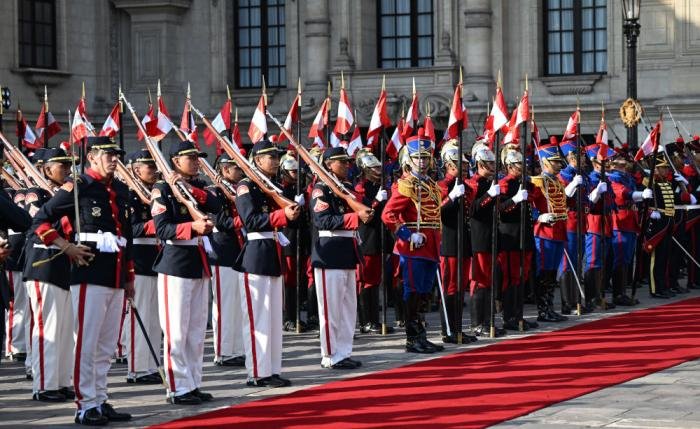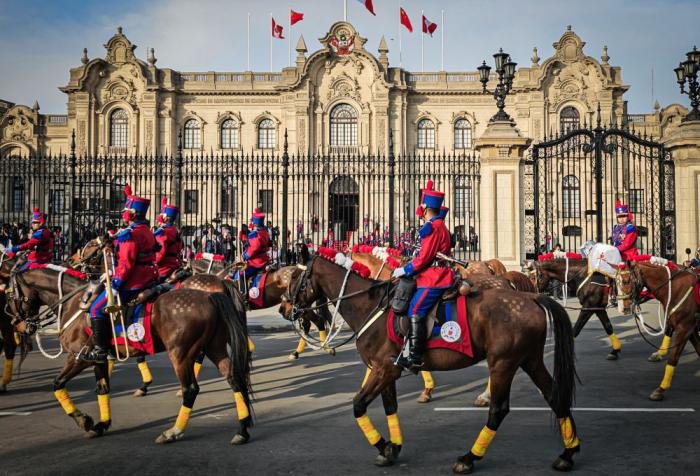
Peruvian President holds welcoming ceremony for President Xi Jinping.
Table of Contents
ToggleOverview of Xi Jinping’s Visit to Peru
On November 14th, President Xi Jinping of China embarked on a notable visit to Peru, marking a significant moment in the diplomatic relationship between the two nations. The visit was inaugurated with a warm welcoming ceremony hosted by Peruvian President Dina Boluarte in Lima, symbolizing the strength and importance of bilateral ties. This event not only underscores the cordial relations forged over the years but also serves as a platform for fostering deeper cooperation between China and Peru.
During this visit, discussions centered around economic collaboration and mutual interests, aligning closely with the Belt and Road Initiative (BRI), a strategic project aimed at enhancing regional connectivity and trade through infrastructure development. The BRI has been instrumental in expanding China’s influence across Latin America, with Peru being a pivotal partner in this endeavor. The implications of Xi Jinping’s engagement in Peru extend beyond mere diplomacy; they signal stronger economic partnerships and investments in various sectors, such as infrastructure, energy, and technology.
This visit also holds the potential to reshape the landscape of international relations in the region, as Peru stands to benefit from increased access to Chinese markets and investment opportunities. The welcoming of President Xi Jinping not only emphasizes Peru’s strategic importance to China’s global ambitions but also highlights the country’s commitment to strengthening ties with one of the world’s largest economies. As both nations explore avenues for expanded cooperation, the visit establishes a foundational narrative for future collaboration, setting the stage for enhanced connectivity through various initiatives, including the significant Chancay Port Project.
The Chancay Port Project: A Strategic Investment for China and Peru
The Chancay Port Project represents a significant step forward in enhancing maritime connectivity between China and Peru while contributing to the economic landscape of South America. As the first smart port in the region, Chancay is designed to utilize advanced technologies to streamline operations, thus making it a vital asset in the logistics network of both nations. The port’s construction is set to unfold in multiple phases, with Phase I focusing on establishing infrastructure capabilities that enable efficient cargo handling and improved logistics management.
The strategic investment in Chancay incorporates not only state-of-the-art technology but also materials sourced from Chinese suppliers, exemplified by the fencing solutions provided by Commandfence. This aspect of the project showcases the collaboration between China and Peru, marking a milestone in the Belt and Road Initiative, which aims to enhance trade routes and economic ties globally. The importance of the Chancay Port Project extends beyond its initial construction phase; it is a pivotal component of a broader strategy to reduce logistics costs significantly, thereby promoting smoother trade flows and fostering economic growth.
The economic benefits stemming from the Chancay Port are manifold. As the port becomes operational, it is projected to generate substantial revenue for Peru through increased cargo traffic and port fees, reinforcing the nation’s standing as a critical logistics hub in the region. Additionally, the project is expected to create numerous job opportunities, leveraging both skilled and unskilled labor in construction and subsequent port operations. Consequently, the Chancay Port is not only a strategic investment for China but a transformative initiative for Peru, facilitating a new era of connectivity and economic collaboration.
Environmental Initiatives and Social Responsibility
The Chancay Port Project, a pivotal development in the context of Xi Jinping’s recent visit to Peru, underscores a profound commitment to environmental sustainability and social responsibility. As part of this ambitious project, several environmental initiatives have been introduced, focusing on the preservation of local ecosystems while promoting economic growth. The establishment of animal rescue stations is a notable aspect of these initiatives. These facilities are designed to rehabilitate injured or displaced wildlife, providing a sanctuary for species affected by infrastructure development. By prioritizing the welfare of these animals, the project demonstrates a dedication to safeguarding Peru’s rich biodiversity.
Additionally, the commitment to improving local ecological conditions cannot be understated. The developers have pledged to implement measures aimed at restoring and enhancing habitats that may be impacted by construction activities. This includes reforestation projects, which are essential for maintaining the ecological balance and ensuring that native plant and animal life can thrive. Such efforts not only contribute to biodiversity conservation but also serve to educate the local community about the importance of environmental stewardship.
The Chancay Port Project exemplifies the balance between economic development and environmental responsibility. By integrating these initiatives, the project aims to foster a holistic approach to growth. It emphasizes the need for cooperation between government entities, local communities, and environmental organizations to achieve sustainable outcomes. This project serves as a model for future developments, demonstrating that it is indeed possible to progress economically while adhering to principles of ecological conservation and social responsibility. Through these measures, the Chancay Port Project not only seeks to enhance the infrastructural capabilities of Peru but also aims to leave a lasting positive legacy on the environment and society.
Future Prospects: Connectivity and Economic Integration in Latin America
The Chancay Port project represents a significant milestone in enhancing connectivity across Latin America and the Caribbean. Its strategic location, just north of Lima, positions it as a vital transshipment hub that will facilitate efficient transportation networks between the Pacific and Atlantic oceans. As global trade dynamics continue to evolve, the development of such infrastructure is essential in fostering economic integration not only within Peru but across neighboring countries as well. The project can potentially mirror the ancient Inca roadways, symbolizing a new era of interconnectedness across the region.
This modern “Inca road” concept emphasizes the importance of building robust connectivity routes that promote trade and tourism. Enhanced port capabilities at Chancay will likely lead to reduced shipping times and costs, inviting increased trade volumes from various regional stakeholders. Countries such as Ecuador, Colombia, and Chile may benefit from this development, as it provides a gateway for their exports to meet international markets through a more efficient logistical network. The potential for improved transport links will also extend to the import sector, further integrating Peru’s economy with that of its neighbors and the wider global market.
Moreover, the collaborative efforts between China, Peru, and other Latin American nations play a crucial role in driving mutual growth and prosperity. As China strengthens its economic ties through initiatives like the Belt and Road Initiative, the Chancay Port could serve as a model for future projects aimed at enhancing connectivity. Such collaboration has the potential to uplift regional economies, creating jobs and enhancing livelihoods. Building a sustainable framework for economic integration in Latin America necessitates a concerted, multidimensional approach among allies and stakeholders. By leveraging the opportunities presented by the Chancay Port project, a more integrated and economically prosperous Latin America may emerge.






